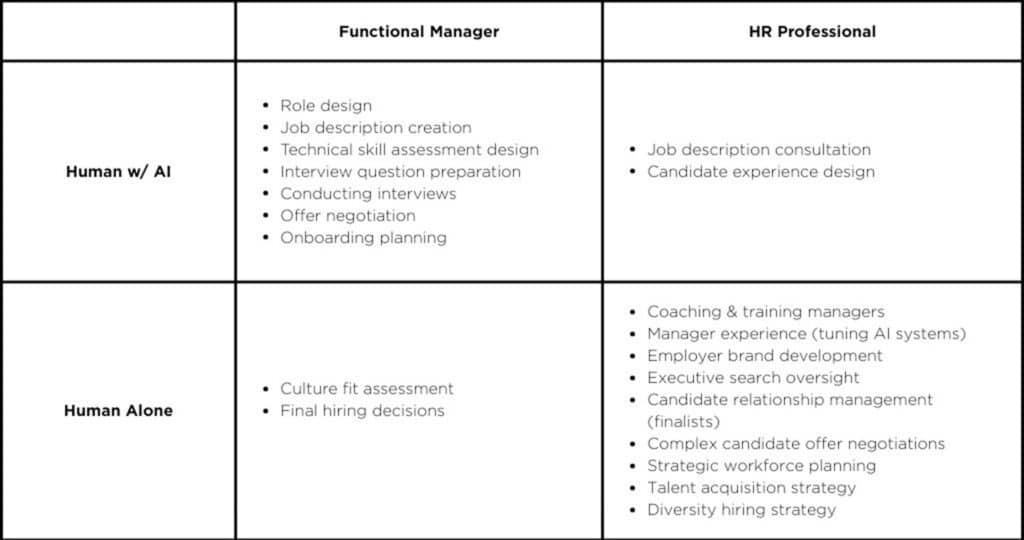Let’s drop the polite fiction: AI is coming for your job. More accurately, it’s coming for your current job. This isn’t a threat but an invitation. While AI will automate many administrative tasks that define HR today, it creates space for an HR transformation that will evolve the function into something far more impactful: a strategic entity centered on unlocking human potential.
There’s a critical difference between AI taking your job and taking your employment. The latter is a dead end, while the former is a doorway.
For decades, forward-thinking chief people officers and CEOs have attempted to transform HR into a more strategic function. Some have succeeded. Many have failed. The persistent administrative burden has thwarted these efforts, leaving HR trapped in transactional work despite best intentions.
HR leaders are not the “culture keepers” or “culture champions.” That’s the CEO’s role.
HR doesn’t design roles, make hiring decisions or lead performance management. Those responsibilities belong to functional managers.
The true value of the chief people officer lies not in managing processes, but in equipping leaders to unlock human potential. This is HR’s real value proposition.
AI is going to take everything else.
3 historical blockers preventing HR transformation
Everything ‘people’ goes in the ‘people department’
HR has accumulated responsibilities by stepping in for reluctant managers based on a flawed premise: Anything people-related belongs to the people department.
Take role design as an example. How a business unit organizes to deliver outputs is among the most critical decisions a manager makes. The accountabilities assigned to each role and who fills it are foundational decisions. Yet, when it’s time to define outcomes, responsibilities and success measures, many managers say, “I’m too busy. HR, you do this.”
The job description becomes mere paperwork, and the manager’s ability to drive achievement, communicate with candidates and manage performance diminishes because someone else did the thinking for them.
Tasks and administration crowded out consultation and strategy
HR remains trapped in administrative work despite a decade of calls for strategic transformation. Over 250 peer-reviewed articles have advocated for this shift, yet little has changed.
Consider the time spent on recruitment logistics, resources devoted to work anniversaries and recognition programs, and the performance management cycle orchestration. According to HR Brew, AI co-pilots can accelerate employee search speeds by 95%, while streamlining routine tasks like processing leave requests and benefits enrollment.
These tasks must be done, but they’ve consumed HR’s bandwidth, undermining its true purpose—driving strategic human capital decisions that create organizational success.
Compliance and regulatory responsibilities misplaced in HR
HR has become the default home for compliance and regulatory tasks. These activities don’t require people strategy expertise—they demand process discipline, risk controls and legal interpretation. This misplacement blurs the lines between governance and people leadership, cementing HR’s image as an enforcement function rather than a growth partner.
Technology changes everything for HR transformation

Forward-thinking organizations are evolving to view work in three dimensions:
- activities only humans can perform;
- activities led by humans and supported by AI (co-pilot systems); and
- activities entirely performed by AI (agentic systems).
By embracing AI systems, we can move from routine administration toward human talent intelligence. In this landscape, AI doesn’t just automate tasks—it delivers real-time insights, decision support and predictive analytics.
As Harvard Business Review points out in “How Gen AI Could Change the Value of Expertise,” generative AI fundamentally shifts HR’s focus from transactional tasks to human capital intelligence, enabling predictive workforce analytics and strategic decision-making capabilities.
Rules vs. judgment: Understanding AI’s HR capabilities
We must distinguish between two types of work:
Rules-based processes follow clear logic patterns with predictable inputs and outputs—payroll calculations, benefits enrollment, compliance reporting—making them ideal for full automation.
Judgment-based processes require contextual understanding and nuanced interpretation that AI cannot replicate. Whether navigating cross-cultural miscommunications or supporting employees through personal crises, human empathy remains irreplaceable.
The future of HR isn’t complete replacement but intelligent division: Automation handles rules-based processes while HR professionals apply their uniquely human capabilities where empathy, cultural understanding and contextual wisdom create the most value.
Reskilling junior HR professionals
Junior HR professionals face the most significant disruption, as their traditional entry path—processing paperwork, coordinating logistics and handling basic inquiries—will rapidly be automated. They need to actively pursue three skill domains:
- Data literacy and analytics: Becoming translators of complex workforce data
- Human-AI collaboration and system design: Creating effective human-AI workflows
- Strategic business acumen and consultation: Developing business fluency and consulting methodologies
A glimpse into the future
Activities that will be fully automated by AI:
- Market compensation analysis
- Sourcing candidates
- Resume screening
- Job posting distribution
- Initial candidate engagement
- Candidate scheduling
- Interview feedback collection
- Candidate relationship management (all initial candidates)
- References and background verification
- Recruitment analytics

Beginning the AI in HR transformation

Start by cataloging current activities: what can be automated immediately, what requires human-AI collaboration and what demands exclusively human judgment.
Buy systems for early adoption—this is about speed. Begin with pilot projects delivering quick wins. Microsoft’s HR transformation offers compelling evidence of this approach’s effectiveness: It reduced report-to-insights time by 82% using AI-driven analytics, allowing HR to reallocate 13 full-time employees to more strategic roles.
Create transitional roles bridging administrative and strategic functions: talent intelligence analysts, manager enablement specialists or organizational capability architects. These stepping stones allow professionals to build strategic capabilities while leveraging existing expertise.
A call to action: leading the evolution of HR
Chief people officers must initiate candid conversations with CEOs about responsibility realignment. The CEO’s mandate is essential—redefine HR’s strategic purpose, redistribute misplaced responsibilities, invest in AI tools and engage HR as advisors rather than process managers.
As an HR professional, your journey will unfold incrementally. Each AI system implementation creates space for higher-value responsibilities. This cycle of technology adoption, role evolution and professional growth propels you toward strategic leadership.
This transformation offers what many in our profession have sought: moving beyond administration to truly influence organizational direction through people leadership.
The time to act is now. Leaders who drive this change will shape both HR’s future and their organization’s competitive advantage. Don’t wait for disruption—the tools exist today. The question isn’t whether AI will transform HR, but whether you’ll lead that transformation. Your profession stands at a crossroads; choose strategic evolution and define what comes next.



